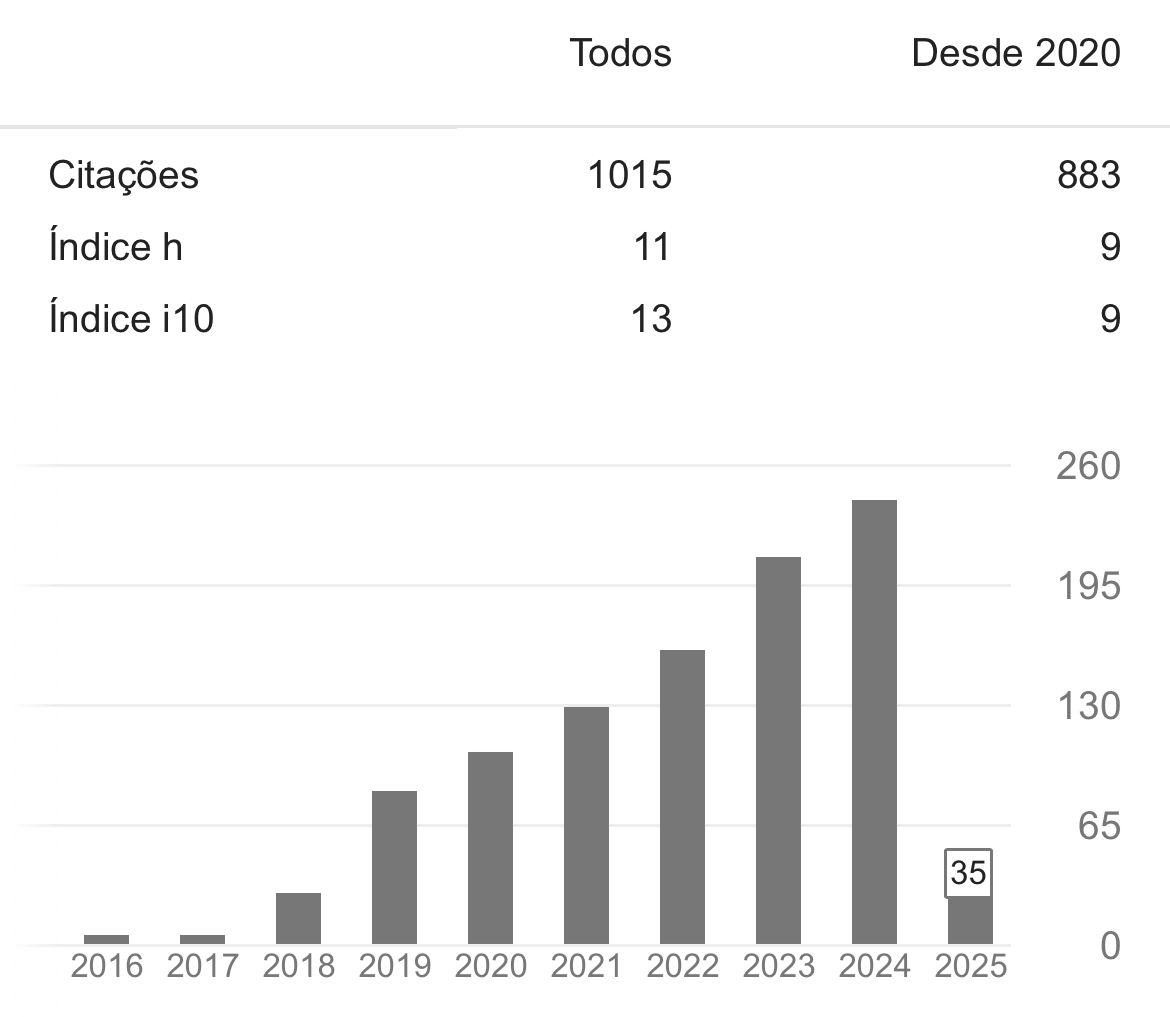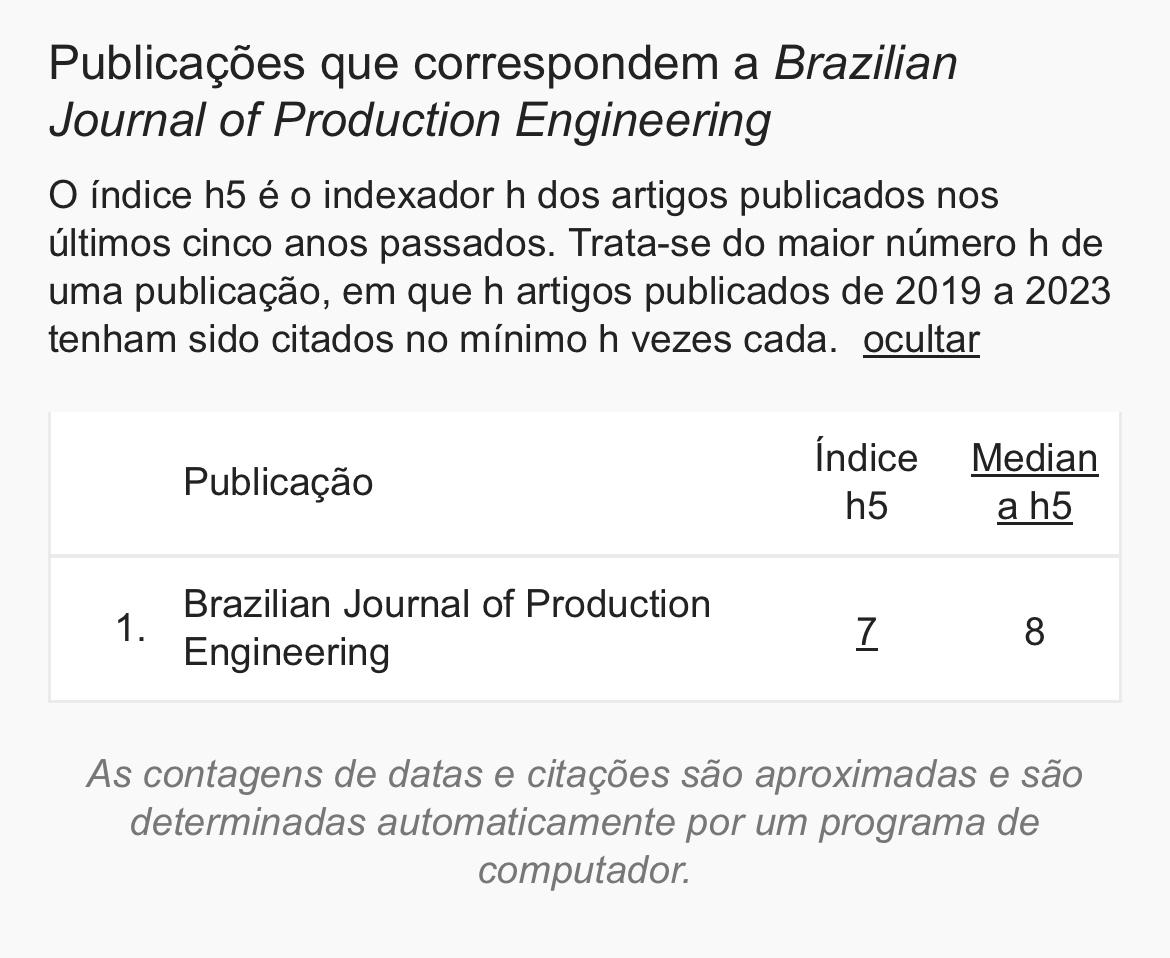Desenvolvimento e implementação da metodologia FTA-FMEA6 para melhoria de processos na manufatura
DOI:
https://doi.org/10.47456/bjpe.v9i4.42594Palavras-chave:
CEP, FAT, FMEAResumo
O presente estudo apresenta os resultados da metodologia desenvolvida através da integração das ferramentas de Árvore de Falhas (FTA) e Análise de Modo e Efeito de Falha (FMEA), denominada FTA-FMEA6. O objetivo foi reduzir a variação e aprimorar a estabilidade no processo de fundição por gravidade de insertos metálicos em uma subárea dedicada aos acumuladores elétricos de uma multinacional do setor automotivo, situada em Belo Jardim/PE. Após a aplicação da metodologia proposta, foram identificadas 21 oportunidades de aprimoramento e em seguida, ações foram implementadas que resultaram em modificações no equipamento e no processo, cujos indicadores de capacidade do processo, evidenciaram uma mudança significativa para a organização, por meio da redução da variação e instabilidade no processo.
Downloads
Referências
Ansori, I. et al. (2023). Enhancing Brake System Evaluation in Periodic Testing of Goods Transport Vehicles through FTA-FMEA Risk Analysis. Automotive Experiences, 6(2). https://doi.org/10.31603/ae.8394 DOI: https://doi.org/10.31603/ae.8394
Behnia, F., Ahmadabadi, H. Z., Schuelke-Leech, B. A., & Mirhassani, M. (2023). Developing a Fuzzy Optimized Model for Selecting Maintenance Strategy in Paper Industry: An Integrated FGP-ANP-FMEA approach. Expert Systems with Applications, 120899.
Calegari, G. & Ferreira, T. S. (2018). Aumento da Rentabilidade da Linha de Bebidas de Uma Cooperativa Agroindustrial pela Execução de um Projeto Lean Seis Sigma. Trabalhos de Conclusão de Curso do DEP, 13(1).
Chen, K. T., Chen, H. Y. W., Bisantz, A., Shen, S., & Sahin, E. (2023). Where failures may occur in automated driving: a fault tree analysis approach. Journal of cognitive engineering and decision making, 17(2), 147-165. https://doi.org/10.1177/15553434221116254 DOI: https://doi.org/10.1177/15553434221116254
Dias Júnior, E. B. & Cavaignac, A. L. de O. (2019). Avaliação de riscos e priorização de falhas por meio do FMEA em serviços elétricos de baixa, média e alta tensão. Brazilian Journal of Production Engineering, 5(3), 214-225.
Ervural, B. & Ayaz, H. I. (2023). A fully data-driven FMEA framework for risk assessment on manufacturing processes using a hybrid approach. Engineering Failure Analysis, 152, 107525. https://doi.org/10.1016/j.engfailanal.2023.107525 DOI: https://doi.org/10.1016/j.engfailanal.2023.107525
Exler, R. B., & de Lima, C. J. B. (2017). Controle Estatístico de Processos (CEP): uma ferramenta para melhoria da qualidade. Revista de Administração e Contabilidade da FAT, 4(3), 78-92.
Falconi, V. (1992). TQC Controle da Qualidade Total no estilo japonês. Rio de Janeiro: Bloch, 158.
https://doi.org/10.1016/j.eswa.2023.120899 DOI: https://doi.org/10.1016/j.eswa.2023.120899
Liu, Z., Li, Y., Zhang, N., Liang, Z., & Li, F. (2021). Reliability analysis of CFRP-packaged FBG sensors using FMEA and FTA techniques. Applied Sciences, 11(22), 10859. https://doi.org/10.3390/app112210859 DOI: https://doi.org/10.3390/app112210859
Liu, Z., Zhao, Y. & Liu, P. (2023). An integrated FMEA framework considering expert reliability for classification and its application in aircraft power supply system. Engineering Applications of Artificial Intelligence, 123, 106319. DOI: https://doi.org/10.1016/j.engappai.2023.106319
Malheiro, M., Souza, M., Borges, M. F., dos Santos Nunes, L., & de Carvalho Gomes, L. (2019). Implantação da ferramenta da qualidade FMEA no processo de manutenção de empilhadeiras de 7 toneladas em uma empresa de agenciamento marítimos. Revista Técnico-Científica do IFSC, 1(8), 50-50.
Marconi, M. D. A. & Lakatos, E. M. (2022). Metodologia Científica (8th ed.). Grupo GEN. https://integrada.minhabiblioteca.com.br/books/9786559770670.
Moura, C. (2000). Análise de modo e efeitos de falha potencial (FMEA). Manual de Referência.
Mutlu, N. G. & Altuntas, S. (2019). Hazard and risk analysis for ring spinning yarn production process by integrated FTA-FMEA approach. Textile and Apparel, 29(3), 208-218. https://doi.org/10.32710/tekstilvekonfeksiyon.482167. DOI: https://doi.org/10.32710/tekstilvekonfeksiyon.482167
Nizer, P., Rahmeier, P. H. N., de Oliveira Littiere, T., de Rosso, D. D. O., & Wiedenhoft, A. G. Análise geométrica dos canais de ataque no processo de fundição por gravidade. Anais do Salão Internacional de Ensino, Pesquisa e Extensão, 10(2).
Öztürk, F., Sakalli, A. E., Gökmen, T. A. K., & Tarakçi, E. (2023). Tenerife Accident Analysis: a comparison of Fault Tree Analysis, Failure Mode and Effects Analysis and Causal Analysis based on System Theory. Gazi University Journal of Science, 36(2), 773-790. https://doi.org/10.35378/gujs.1014604 DOI: https://doi.org/10.35378/gujs.1014604
Pacheco, Y. C. K. G., Ribeiro, R. K. P., & Cavaignac, A. L. de O. (2019). Utilização da análise de modos de falhas e efeitos (FMEA) como ferramenta de prevenção de acidentes em operações com usos de pontes rolantes. Brazilian Journal of Production Engineering, 5(4), 10-24.
Park, S. J., Kwak, Y. G., Song, S. G., & Kang, F. S. (2023). Comparison of reliability and economic feasibility for the three configurations of multiple battery charging systems. IET Electrical Systems in Transportation, 13(2), e12082. https://doi.org/10.1049/els2.12082. DOI: https://doi.org/10.1049/els2.12082
Peeters, J. F. W., Basten, R. J., & Tinga, T. (2018). Improving failure analysis efficiency by combining FTA and FMEA in a recursive manner. Reliability engineering & system safety, 172, 36-44. https://doi.org/10.1016/j.ress.2017.11.024 DOI: https://doi.org/10.1016/j.ress.2017.11.024
Revista Ferramental. Fundição: o que é e como funciona? (2021). Recuperado de https://www.revistaferramental.com.br/artigo/fundicao-o-que-e-e-como-funciona/
Santana, A. D. S. (2016). Identificação dos Principais Defeitos de Fundição Através da Aplicação de Ferramentas da Qualidade: Estudo de Caso em uma Fundição de Peças Metálicas. 2016. 96 p. Trabalho de Conclusão de Curso (Bacharel em Engenharia de Produção) - Centro Universitário Católico de Vitória, Vitória, Espírito Santo.
Santos, A. G. S., Jorge, G. P. do N., & Cavaignac, A. L. de O. (2019). FMEA como ferramenta de identificação dos riscos ao trabalhador da construção civil. Brazilian Journal of Production Engineering, 5(3), 19–34.
Silva, C. V. N., Cavaignac, A. L. de O., & Uchoa, J. G. L. (2020). Análise dos modos e efeitos de falhas na instalação de energia solar em telhados residenciais de Imperatriz/MA: uma abordagem da ferramenta FMEA. Brazilian Journal of Production Engineering, 6(7), 45-57. https://doi.org/10.47456/bjpe.v6i7.32582. DOI: https://doi.org/10.47456/bjpe.v6i7.32582
Silveira, C. B. (2012). Cp e Cpk–Índices de capacidade de um processo. Citisystems, São Paulo, nov.
Soriano, F. R., Oprime, P. C., & Lizarelli, F. L. (2020). Os fatores que devem ser considerados para uma efetiva implantação do controle estatístico de processo (CEP): uma revisão de literatura. Revista Gestão da Produção Operações e Sistemas, 15(1), 71-71. DOI: https://doi.org/10.15675/gepros.v15i1.2259
Taha, H. A., Yacout, S., & Shaban, Y. (2023). Online failure analysis and autonomous risk control scheme for electric buses. Engineering Failure Analysis, 107629.
https://doi.org/10.1016/j.engfailanal.2023.107629. DOI: https://doi.org/10.1016/j.engfailanal.2023.107629
Yazdi, M., Mohammadpour, J., Li, H., Huang, H. Z., Zarei, E., Pirbalouti, R. G., & Adumene, S. (2023). Fault tree analysis improvements: a bibliometric analysis and literature review. Quality and Reliability Engineering International. https://doi.org/10.1002/qre.3271. DOI: https://doi.org/10.1002/qre.3271
Zahaikevitch, E. V., Gura, A., Fonseca, M. H., Bittencourt, J. V. M., & de Francisco, A. C. (2019). Contribuição das Ferramentas da Gestão da Qualidade para a Gestão do Conhecimento nas Empresas: Uma Revisão Bibliométrica na base de dados Scopus. Revista Mundi Engenharia, Tecnologia e Gestão, 4(1). DOI: https://doi.org/10.21575/25254782rmetg2019vol4n1721

Downloads
Publicado
Como Citar
Edição
Seção
Licença
Copyright (c) 2023 Brazilian Journal of Production Engineering

Este trabalho está licenciado sob uma licença Creative Commons Attribution-NonCommercial-ShareAlike 4.0 International License.

Atribuição 4.0 internacional CC BY 4.0 Deed
Esta licença permite que outros remixem, adaptem e desenvolvam seu trabalho não comercialmente, contanto que eles creditem a você e licenciem suas novas criações sob os mesmos termos.
















































































